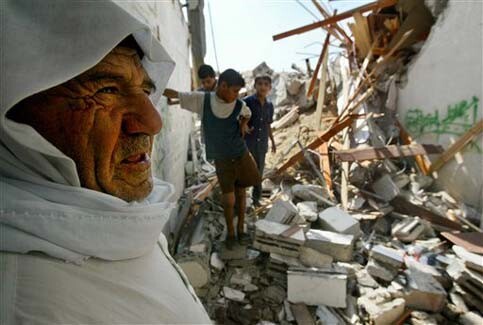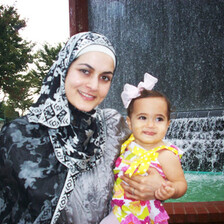Gaza 11 October 2004

A family surveys the damage incurred during the Israeli invasion of the northern Gaza Strip (Photo: PCHR)
The last thing that young Suha Ayub Ibayd remembers before a barrage of tank fire ripped through her home is huddling together with her parents and eight brothers and sisters.
They had taken cover in the middle of their living-room floor hoping to find shelter from the mass of military machines that had rumbled into their neighbourhood minutes earlier on October 6.
Now she lies listlessly in her hospital bed, trying to absorb as well as any nine-year-old could the events of that morning.
She survived with relatively light wounds. The same cannot be said, however, about her younger sister, fighting for her life in the hospital’s intensive care unit, or about many of her neighbours.
One of them, 15-year-old Abd Allah Qahtan, died instantly in the pre-dawn Israeli attack on civilian homes in the northern Gaza Strip of Bait Lahya, while Hamdan Ubaid and his son Hamuda were killed on their way to the mosque for morning prayers.
They are the latest victims in Israel Prime Minister Ariel Sharon’s bloody offensive through the northern Gaza Strip, which has claimed more than 85 Palestinian lives, nearly 30 of them children.
Smoke and screams
The military operation was launched after two Israeli children were killed on 29 September in a Hamas rocket attack on Sderot, near the Gaza border.
“I saw two or three tanks and several bulldozers razing farmland near our house,” Ibayd’s mother Somaya said, recounting a tale of shock and horror.
“We took cover in the living room. Then out of nowhere the tanks shells hit us … all I remember after that is seeing smoke … all I remember is smoke and screams and ambulances.”
Somaya’s injured family members are spread out in hospitals across Jabalya.
Kamel Udwan Hospital in Bait Lahya, where she is staying, is working five times its 60-bed capacity, with hospital staff forced to turn the cafeteria into an outpatient clinic.
Somaya’s 18-month-old daughter is under observation in Gaza’s Shifa Hospital, with fragments of shrapnel lodged in her head and guts. Doctors’ predictions for her survival are dismal.
Somaya hasn’t spoken to her since the attack on Wednesday morning, preoccupied instead with attending to five-year-old Sabrin, who was lying by her side, wracked by violent spasms of pain.
She too was hit in the head, which was seeping blood and roughly bandaged with the limited supplies available to the under-stocked hospital.
Complete shock
Across the room was Sabrin’s seven-year-old brother Alaa, whose face was badly burned and whose frail young body was dotted with shrapnel wounds.
He stared blankly at family members who tried futilely to elicit a response from him. Alaa hadn’t spoken a word since early in the morning, with a look of fear frozen on his tender face.
“He’s suffering from complete shock,” his aunt Badriah said. “He used to be the most talkative one of the group.”
Israeli military sources said occupation troops only opened fire at civilian homes after an anti-tank rocket was launched from one of the houses in the town.
But according to Somaya, the attack was completely unprovoked - there were neither fighters nor rockets in the area.
Lucky to live
“It’s a very quiet area. The resistance fighters don’t come here, and there was nothing fired from our house. Absolutely nothing,” Somaya said.
Her family was lucky enough to live and tell their tale, which gives further credence to Palestinian claims that Sharon’s weeklong charge through northern Gaza is more about inflicting as much damage and pain as possible, than about protecting Israeli towns.
“They target every living thing. They have no mercy in their hearts,” Badria said.
According to the assistant director of the Kamal Udwan Hospital, Dr. Said Joudeh, the injuries he’s seen have been the most extensive and penetrating in the four years of the intifada.
Serious injuries
“I’ve been working here a long time, and I’ve seen some pretty horrible things - but nothing like this, and not with this frequency,” Dr Joudeh said.
“People have been arriving here with their bowels ripped inside out, with their limbs torn off, their bodies burned beyond recognition, and dozens of bullet fragments that exploded upon impact lodged mainly in the upper half of their bodies.
“The injuries are highly serious, with evidence of direct hits intended to cause as much damage as possible.They are penetrating, crushing and destructive.”
Badria’s nine-year-old son told her after seeing what happened to his cousins, he wants to become a resistance fighter.
As for young Suha, she says she dreams one day of becoming a doctor “so she can treat injured people” like herself.
Her aunt is not so hopeful. “She keeps saying she wants to become a medic. But there is no room in our lives for dreams anymore.”
This article was originally published by aljazeera.net.
Related links:




